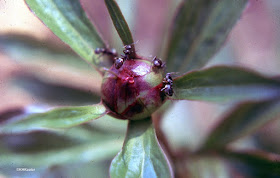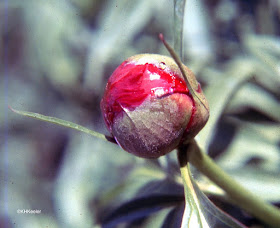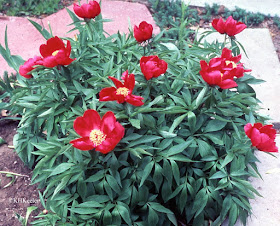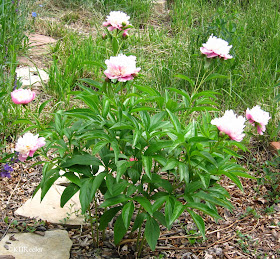 |
| Fly on wild rose |
Sunday, June 26, 2016
Pollinator Week--A Mountain Walk Looking for Pollinators
This was Pollinator Week.
I hiked in Rocky Mountain National Park, taking time to watch the pollinators.
Sunday, June 19, 2016
Plants with Extrafloral Nectaries
Why are there ants on the peony buds?
The simple answer is because peony buds secrete nectar (sugar water).
Why do peony buds secrete nectar?
There is no definitive answer to that question, but, based on studies of other plants, to attract ants which defend the plant from damage.
 |
| Ants taking nectar from peony extrafloral nectaries. |
 |
| Drop of nectar on peony bud (upper right) |
There is no definitive answer to that question, but, based on studies of other plants, to attract ants which defend the plant from damage.
Sunday, June 12, 2016
Plant Story--Peonies from Europe
Its always a joy when the peonies flower!
Europeans have been using two of their five native peonies, the female peony Paeonia officinalis (link) and the male peony P. mascula (link) medicinally for millennia.
It is not obvious today why they are called male and female. It does not reflect the botany. Both are male, in the sense of having pollen (sperm) and both are female, in the sense of having eggs within ovules that develop into seeds. In both species, both "male" and "female" function occur within the same flower (hermaphrodite flowers). Furthermore that explanation is relatively recent--that plants did any kind of sexual reproduction was one of Linneaus' absolutely shocking suggestions in the late 1700s. Peonies were called male and female long before that.
The Bynums in Remarkable Plants suggest that the designation reflects the relative size and vigor of the two plants, male peonies being larger than female peonies.
Europeans have been using two of their five native peonies, the female peony Paeonia officinalis (link) and the male peony P. mascula (link) medicinally for millennia.
It is not obvious today why they are called male and female. It does not reflect the botany. Both are male, in the sense of having pollen (sperm) and both are female, in the sense of having eggs within ovules that develop into seeds. In both species, both "male" and "female" function occur within the same flower (hermaphrodite flowers). Furthermore that explanation is relatively recent--that plants did any kind of sexual reproduction was one of Linneaus' absolutely shocking suggestions in the late 1700s. Peonies were called male and female long before that.
The Bynums in Remarkable Plants suggest that the designation reflects the relative size and vigor of the two plants, male peonies being larger than female peonies.
Sunday, June 5, 2016
Plant Stories: Peonies from the Orient
Peonies! Wonderful big flowers and a rich scent. No wonder they've been favorites for millennia.
Peonies are plants of the genus Paeonia. It is the only genus in the peony family, the Paeoniaceae. There are 33 species, very like each other and not like much of anything else. They have an odd distribution: two species are native to the western US, a few species are found in southern Europe and across Asia but most peonies are native to eastern Asia.
The Chinese have been cultivating peonies for more than 3,000 years (written records from the early Zhou Dynasty (1046-256 BCE)), creating hybrids, doubles and new colors. The Chinese particularly liked tree peonies (mǔ
Wednesday, June 1, 2016
Where to Buy Milkweeds to Grow in Colorado
Colorado, straddling the Rocky Mountains, has, on the eastern side--Front Range--monarch butterflies from the eastern North American population and on the Western Slope, butterflies from the western monarch population. Colorado doesn't fit neatly into the current "Grow Milkweeds for Monarchs!" push because the common milkweed, Asclepias syriaca is not native here.
Monarch caterpillars eat only milkweeds, so reductions in milkweed populations reduce monarch butterfly numbers.
Milkweeds are native all across North America--there are 140 species--but that "weed" in their name makes us assume they are ubiquitous. Far from it. Planting milkweeds to help monarch butterflies find it easier to find food for their larvave makes very good sense.
The common milkweed (A. syriaca) doesn't grow in Colorado. Since there are 19 species of milkweed native to Colorado, it only makes sense to grow those. The easiest to grow is the showy milkweed, Asclepias speciosa It is the milkweed you see in Colrado side-lots and roadside ditches. It looks a lot like the common milkweed.
Monarch caterpillars eat only milkweeds, so reductions in milkweed populations reduce monarch butterfly numbers.
 |
| a Colorado milkweed showy milkweed, Asclepias speciosa |
The common milkweed (A. syriaca) doesn't grow in Colorado. Since there are 19 species of milkweed native to Colorado, it only makes sense to grow those. The easiest to grow is the showy milkweed, Asclepias speciosa It is the milkweed you see in Colrado side-lots and roadside ditches. It looks a lot like the common milkweed.


